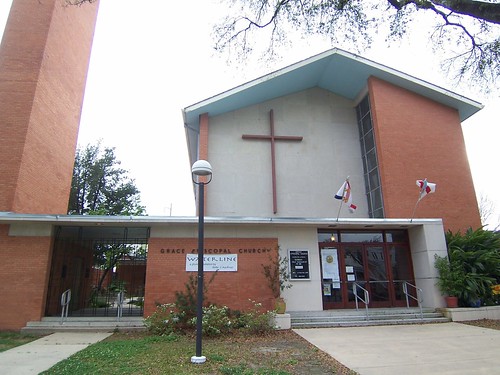In 1994 Tulane School of Architecture sponsored a tour, "The International Style in New Orleans" which featured six modern buildings designed by alumni and faculty in New Orleans: Nathaniel C. Curtis, Jr., Arthur Q. Davis, John Lawrence, James Lamantia, Albert C. Ledner, and August Perez, Jr. This will be the first of six posts in a series. We'll start our tour on Canal Street.
Grace Episcopal Church
3700 Canal Street
Architects: August Perez, Jr., and Associates
Principal Architect: Andrew Schneider
The building on our tour today is the third home of Grace Episcopal Church and was designed in 1953 to replace the structure in the 1500 block of Canal Street.* It reflects numerous compromises between the traditionalist building committee and the more modern architects, backed by Father Sherwood Clayton.
The floor plan for worship areas, offices and classrooms were the architects’ first consideration, and the brick exterior followed. The tower is about 60’ high. In the church, the narrow nave enhances a feeling of height, and the materials- oak and unadorned plaster- are in keeping with 1950’s decorative ideas. Brought from the earlier church, the pipe organ is behind the reredos, with its simple geometric design.
The architects designed the red marble altar, the iron gates with their clustering of geometric shapes in groups of three, and the stained glass windows. The windows, of abstracts shapes, create “ribbons of light” and we will see this form in the other two churches on tour today. Payne & Co., of New England, created the windows. The immense murals were designed in 1954 or 1955 by John McCrady (1911-1968) of New Orleans. A parishioner of Grace Episcopal Church, McCrady also painted the Communion Mural, incorporating the marble altar, Father Clayton, and replicas of his own hands into it. Funds for the Ascension Mural were not available until 1973, when Alan R. Flattmann painted the mural following McCrady’s sketch. McCrady developed the paint, a special mixture of oil paint and wax to reduce glare. The mural walls, actually double panels with a space between to minimize climatic stress, were coated with a special plaster.
The adjacent St. Matthias Memorial Chapel includes the altar from the downtown church and windows that were possibly executed by the Emil Frei studio of St. Louis.
3700 Canal Street
Architects: August Perez, Jr., and Associates
Principal Architect: Andrew Schneider
The building on our tour today is the third home of Grace Episcopal Church and was designed in 1953 to replace the structure in the 1500 block of Canal Street.* It reflects numerous compromises between the traditionalist building committee and the more modern architects, backed by Father Sherwood Clayton.
The floor plan for worship areas, offices and classrooms were the architects’ first consideration, and the brick exterior followed. The tower is about 60’ high. In the church, the narrow nave enhances a feeling of height, and the materials- oak and unadorned plaster- are in keeping with 1950’s decorative ideas. Brought from the earlier church, the pipe organ is behind the reredos, with its simple geometric design.
The architects designed the red marble altar, the iron gates with their clustering of geometric shapes in groups of three, and the stained glass windows. The windows, of abstracts shapes, create “ribbons of light” and we will see this form in the other two churches on tour today. Payne & Co., of New England, created the windows. The immense murals were designed in 1954 or 1955 by John McCrady (1911-1968) of New Orleans. A parishioner of Grace Episcopal Church, McCrady also painted the Communion Mural, incorporating the marble altar, Father Clayton, and replicas of his own hands into it. Funds for the Ascension Mural were not available until 1973, when Alan R. Flattmann painted the mural following McCrady’s sketch. McCrady developed the paint, a special mixture of oil paint and wax to reduce glare. The mural walls, actually double panels with a space between to minimize climatic stress, were coated with a special plaster.
The adjacent St. Matthias Memorial Chapel includes the altar from the downtown church and windows that were possibly executed by the Emil Frei studio of St. Louis.
--------------------------------------------------------------------------------------------------------------------
* The Texaco Building (Claude E. Hooton, 1951) is on the site of the former Grace Episcopal Church at 1501 Canal Street.
* The Texaco Building (Claude E. Hooton, 1951) is on the site of the former Grace Episcopal Church at 1501 Canal Street.
The International Style in New Orleans, Tulane School of Architecture, 1994, copy by Patty Andrews
photo: Colm Kennedy, Tulane School of Architecture New Orleans Virtual Archive
photo: Colm Kennedy, Tulane School of Architecture New Orleans Virtual Archive


No comments:
Post a Comment